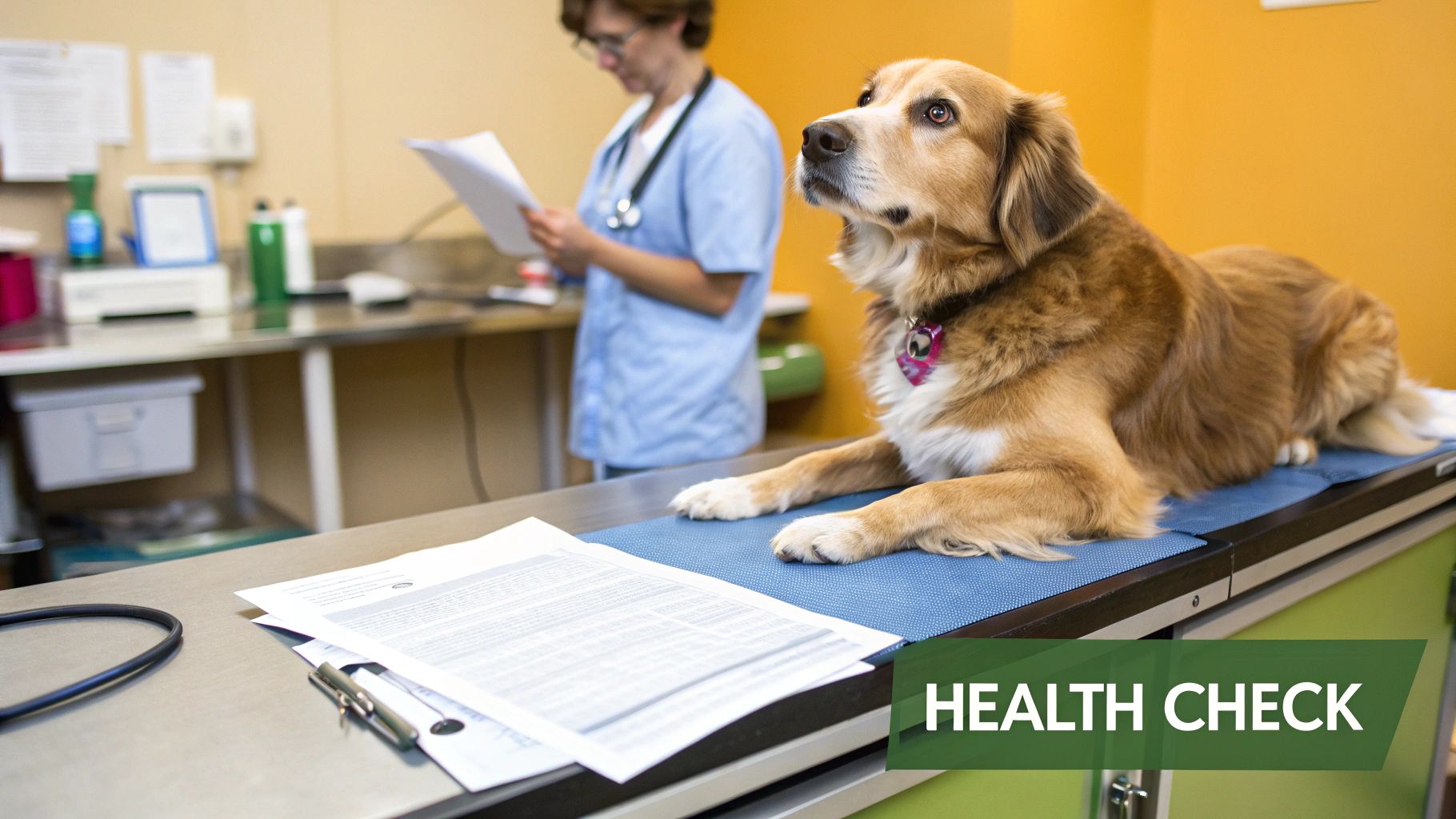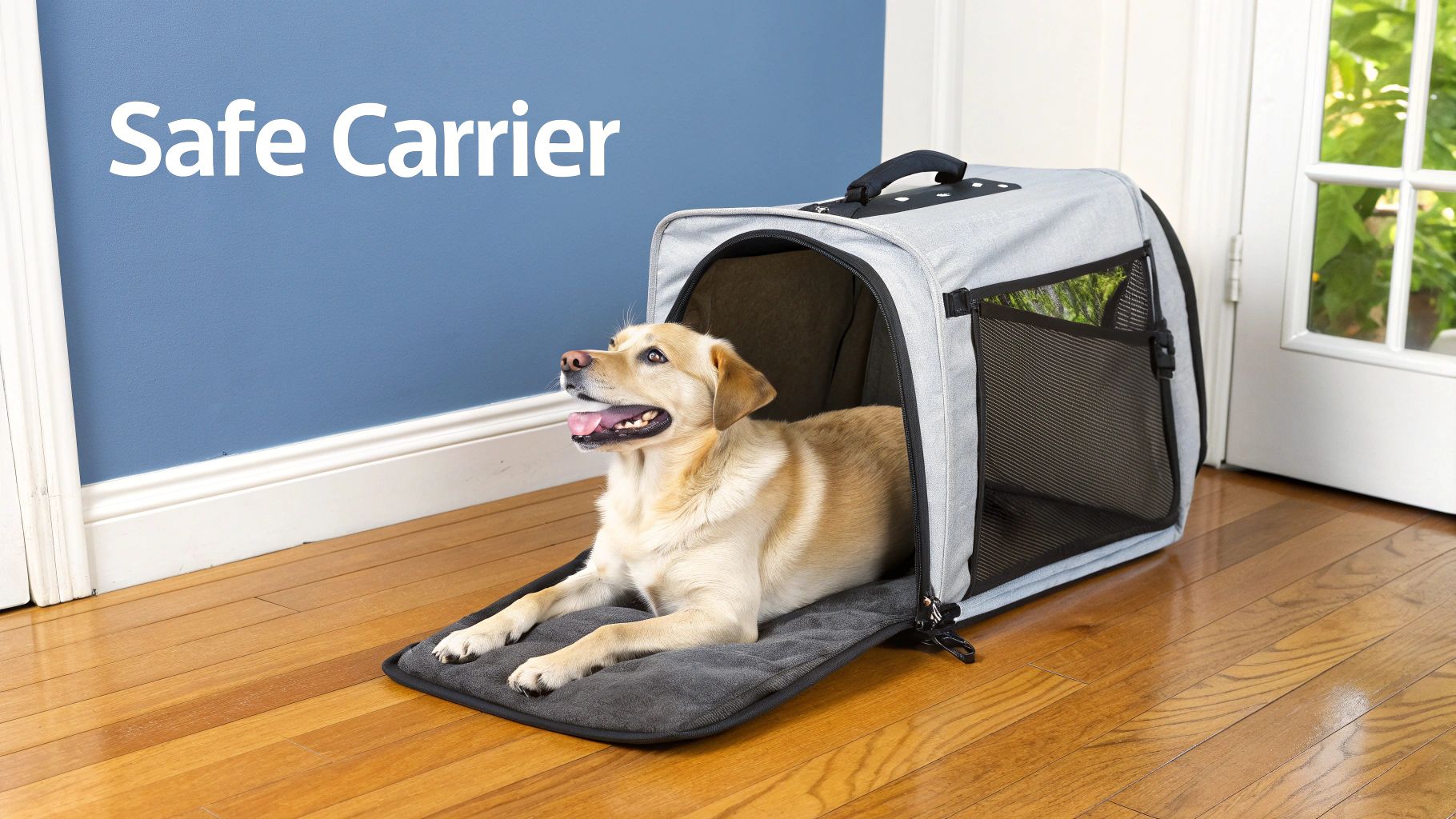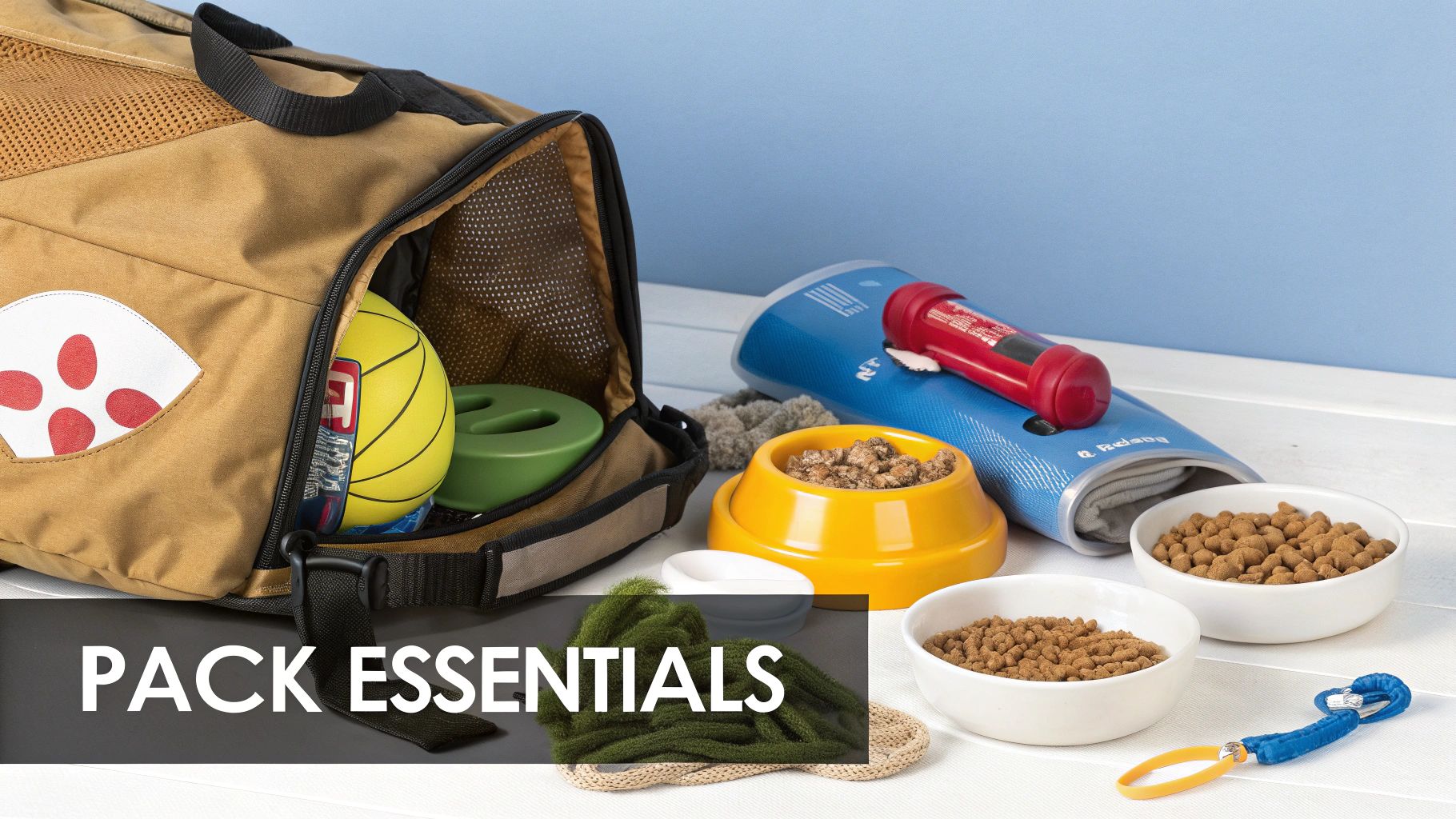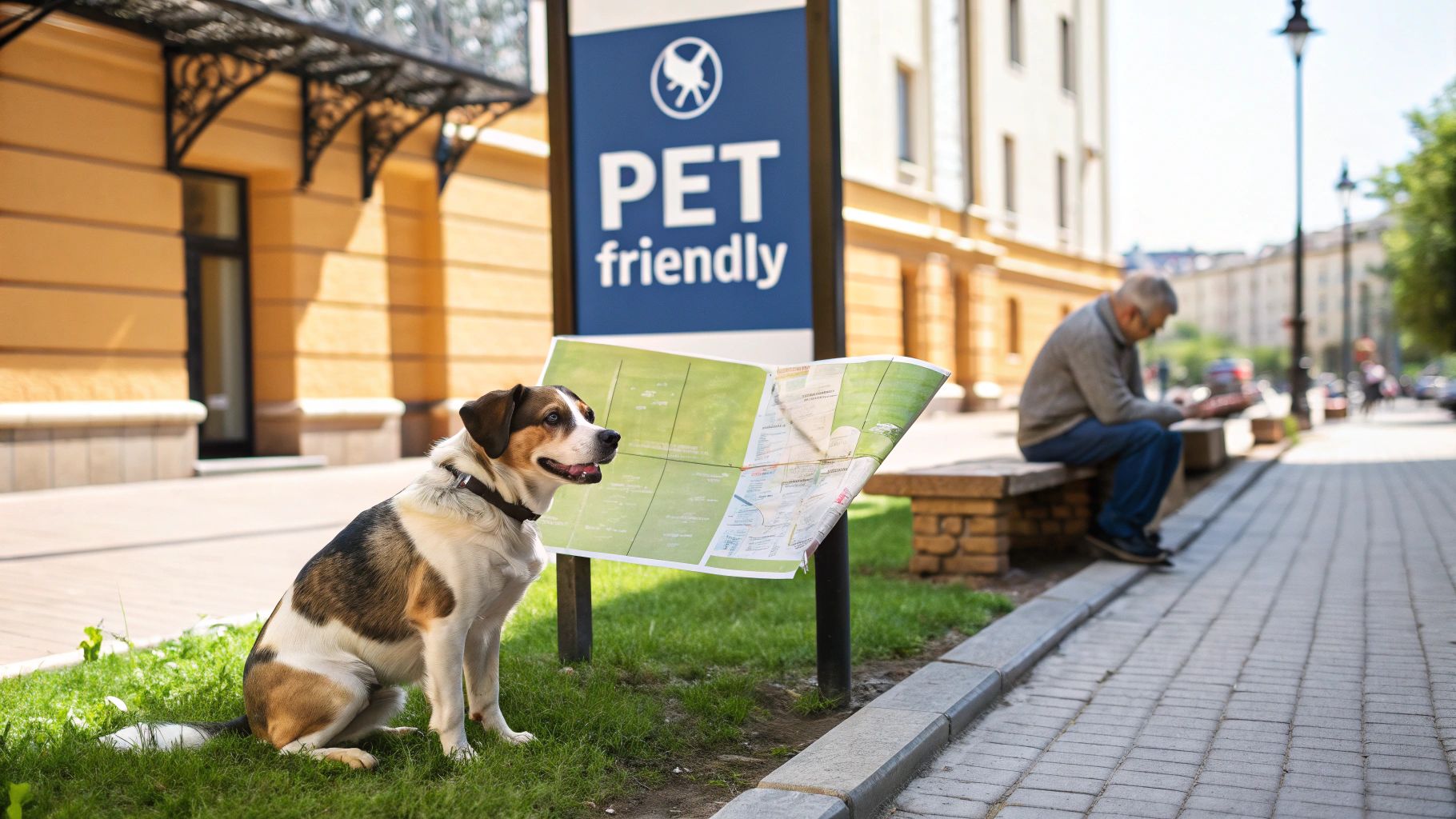Traveling with your dog can be an incredibly rewarding experience, creating memories that last a lifetime. However, a successful trip requires more than just an adventurous spirit; it demands careful planning and preparation. Whether you're embarking on a cross-country road trip or flying to a new destination, ensuring your dog's safety, comfort, and happiness is paramount. This guide provides a comprehensive roundup of essential, actionable travel tips for dogs, designed to equip you for any journey.
We move beyond the basics to offer detailed strategies for every stage of your adventure. You will learn how to properly prepare pre-travel health documentation, select and train for the ideal carrier, and strategically pack all the essentials without over-burdening yourself. We'll also cover critical topics like helping your dog adapt to new climates, optimizing different modes of transportation, and researching pet-friendly destinations to avoid unwelcome surprises.
Furthermore, this listicle dives deep into managing your dog's stress, implementing robust safety protocols, and creating a solid emergency plan. With these expert insights, you and your furry co-pilot will be ready to explore the world together, confidently and safely. Let's get into the details that transform a good trip into a great one.
1. Pre-Travel Health and Documentation Preparation
Before you pack a single suitcase, the most critical step in planning a trip with your pet is ensuring their health and documentation are in perfect order. This foundational task involves consulting your veterinarian to confirm your dog is healthy enough for travel and gathering all necessary paperwork, such as vaccination records and health certificates. This preparation is non-negotiable, as airlines, border agents, and even hotels will require proof of your dog's health status.

Proper documentation prevents devastating travel disruptions, from being denied boarding on a flight to facing mandatory quarantine at your destination. This is a vital first step for anyone looking for practical travel tips for dogs, as overlooking it can end a trip before it even begins.
Why It's Essential
Different destinations and transport providers have strict, non-negotiable health requirements. For instance, traveling to Hawaii without meticulous adherence to their rabies quarantine program can result in a lengthy and expensive 120-day quarantine for your pet. Similarly, many airlines, such as Delta and American Airlines, mandate a Certificate of Veterinary Inspection (CVI), or health certificate, issued within 10 days of your departure. International travel adds another layer of complexity; crossing into Canada, for example, requires a valid rabies vaccination certificate signed by a licensed veterinarian.
Actionable Steps for Success
To ensure a smooth journey, follow these specific preparation steps:
- Schedule a Vet Visit Early: Book an appointment with your veterinarian 3-4 weeks before your travel date. This provides ample time to update necessary vaccinations, conduct health screenings, and process paperwork without a last-minute rush.
- Research Destination-Specific Rules: Visit the USDA Animal and Plant Health Inspection Service (APHIS) website for detailed pet travel requirements for every U.S. state and foreign country. Requirements can change, so always verify the most current information.
- Organize Your Documents: Keep both physical and digital copies of all essential documents in a dedicated travel folder. This includes vaccination records, your pet's microchip information, and the official CVI.
- Confirm Airline Policies: Call your airline directly or check their pet travel policy page online. Ask for specifics on their health certificate timeline, carrier requirements, and any breed-specific restrictions they may have.
2. Proper Travel Carrier Selection and Training
Choosing the right carrier and acclimating your dog to it is a fundamental part of safe and stress-free travel. A carrier is not just luggage; it's your dog's safe space during transit, whether by air or car. The right carrier must meet specific safety standards and be comfortable enough for your dog to rest in for extended periods, making this one of the most important travel tips for dogs.

Without proper selection and training, your dog may experience extreme anxiety, and you risk being denied boarding or facing unsafe conditions. A comfortable, well-trained dog is a calm travel companion, ensuring the journey is pleasant for everyone involved.
Why It's Essential
Airlines have strict regulations regarding carrier size, ventilation, and construction. For example, popular carriers like the Sherpa Original Deluxe are specifically designed to meet most major airline under-seat requirements. For car travel, safety is paramount; brands like Sleepypod offer carriers that are not only airline-approved but also rigorously crash-tested to protect your pet in an accident. Familiarizing your dog with their carrier long before the trip transforms it from a scary box into a familiar den, significantly reducing travel-related stress.
Actionable Steps for Success
To ensure your dog is safe and comfortable, follow these key steps:
- Measure Your Dog Correctly: Your dog must be able to stand up, turn around, and lie down comfortably in the carrier. Measure your dog's height from the floor to the top of their head and their length from the base of their tail to their nose to find the right fit.
- Begin Training Early: Start carrier training at least 2-3 weeks before your trip. Begin by leaving the carrier open in your home with treats and toys inside, allowing your dog to explore it on their own terms.
- Use Positive Reinforcement: Praise and reward your dog every time they interact with or enter the carrier. Gradually increase the time they spend inside with the door closed, always ending on a positive note.
- Practice Short Trips: Once your dog is comfortable, take them on short car rides in the carrier. This helps them associate the carrier with positive, neutral experiences rather than just the stress of a long journey.
3. Strategic Packing of Dog Travel Essentials
Properly packing for your dog goes beyond simply throwing their food bowl and a leash in a bag. Strategic packing involves thoughtfully organizing all essentials to maintain your dog's routine, ensure their comfort and safety, and prepare for unexpected situations. This means creating a dedicated travel kit with pre-portioned meals, medications, comfort items, and cleanup supplies arranged for easy access.

This methodical approach is one of the most practical travel tips for dogs because it minimizes stress for both you and your pet. Having everything your dog needs readily available prevents frantic searching for a poop bag or a dose of medication, allowing you to focus on enjoying the journey together.
Why It's Essential
A well-packed bag ensures consistency in your dog’s routine, which is crucial for reducing travel-induced anxiety. Sudden changes in diet or a missing favorite toy can cause distress. Furthermore, being prepared for emergencies is non-negotiable. Travel can present unexpected challenges like delays, minor injuries, or lost items. A comprehensive kit, including a pet first-aid kit like those from RC Pet Products, ensures you can handle minor issues swiftly without derailing your trip. Forgetting essentials could mean a last-minute scramble to find a pet store in an unfamiliar area.
Actionable Steps for Success
To master the art of packing for your pet, follow these specific steps:
- Pre-Portion Food and Add Extra: Measure out each of your dog's meals into individual resealable bags. Pack at least 25% extra food to account for potential travel delays, spills, or increased activity levels.
- Use Space-Saving Gear: Invest in travel-specific items like collapsible silicone bowls, which can reduce packing space by up to 70% compared to standard bowls. A travel water bottle with an attached dispenser also simplifies hydration on the go.
- Keep Medications Organized: Pack all medications in their original, clearly labeled containers. If flying, keep these essential items in your carry-on bag to avoid issues with lost luggage or temperature fluctuations in the cargo hold.
- Assemble an Essentials Carry-On: For any mode of transport, keep a smaller bag with immediate necessities. This should include a leash, a few poop bags, a small amount of food, water, a favorite chew toy, and any time-sensitive medications.
4. Climate and Environmental Adaptation Planning
A crucial aspect of responsible pet travel involves planning for the specific climate and environment of your destination. Dogs, much like humans, can be sensitive to sudden changes in temperature, altitude, and terrain. Preparing your dog for these shifts is essential for their comfort, health, and safety, ensuring they can enjoy the new surroundings without undue stress or physical harm.

Failing to account for environmental differences can lead to serious health issues, from heatstroke in desert climates to altitude sickness in the mountains. This planning is one of the most important travel tips for dogs, as it directly impacts their well-being and prevents emergencies far from home.
Why It's Essential
Significant environmental changes can overwhelm a dog's system. For example, a dog accustomed to sea level traveling to the Colorado mountains may require 3-5 days to properly acclimate to the lower oxygen levels. Similarly, an Arctic breed like a Siberian Husky visiting a tropical destination faces a high risk of overheating. Companies like Ruffwear have popularized specialized gear, such as cooling vests and protective booties, precisely because these environmental challenges are so common. Understanding these risks allows you to mitigate them proactively.
Actionable Steps for Success
To ensure your dog adapts safely to a new environment, implement these strategies:
- Arrive Early for Acclimatization: If possible, schedule your arrival 2-3 days before any strenuous activities. This grace period allows your dog's body to gradually adjust to significant changes in altitude or temperature.
- Pack Climate-Appropriate Gear: Invest in practical gear for the destination. This could include a cooling vest for a trip to Arizona, a waterproof and insulated coat for the Pacific Northwest, or protective booties for hot pavement or rugged hiking trails.
- Monitor for Signs of Distress: Watch your dog closely for symptoms of discomfort. Key signs of overheating include excessive panting, thick drool, and lethargy. Altitude sickness can present as nausea, dizziness, or fatigue.
- Adjust Exercise Routines: Modify the intensity and timing of physical activities. In hot climates, opt for walks in the early morning or late evening. In high-altitude locations, start with shorter, less demanding walks to avoid overexertion.
5. Transportation Mode Optimization
Choosing the right mode of transport is a cornerstone of safe and stress-free pet travel. This crucial step involves evaluating the best option based on your dog's size, temperament, the travel distance, and your budget. Whether by car, plane, or train, each method has distinct advantages and challenges that must be carefully considered for your pet's well-being.
Optimizing your transportation plan is one of the most impactful travel tips for dogs because it directly affects their comfort and safety. A large, anxious dog may find a long-haul flight extremely stressful, whereas a small, calm pet might handle it with ease. Making an informed choice prevents logistical nightmares and ensures a positive experience for everyone.
Why It's Essential
Different transportation methods present unique environments and regulations. For instance, car travel offers maximum flexibility and control, allowing for frequent potty breaks and a familiar space, which is ideal for anxious pets. Conversely, air travel is faster for long distances but comes with strict crate requirements, cabin limitations, and potential cargo hold stress. Amtrak allows small pets in carriers on many of their routes, but larger dogs are generally not permitted. Failing to match the transport mode to your dog’s needs can lead to significant anxiety, health risks, or being denied travel altogether.
Actionable Steps for Success
To select and prepare for the best transportation method, follow these guidelines:
- Assess Your Dog's Profile: Honestly evaluate your dog's size, breed, age, and temperament. A brachycephalic (flat-faced) breed like a Pug faces higher risks during air travel and may be better suited for a road trip.
- Research Specific Policies: Transportation rules change frequently. Always check the most current pet policies, whether it's an airline, train service, or even a ride-sharing app. For a comprehensive overview of airline specifics, learn more about how to fly with pets from Pet Voyages.
- Plan for Rest Stops: For car travel, map out your route with planned stops every 2-3 hours for your dog to stretch, drink water, and relieve themselves. Never leave your dog unattended in a vehicle.
- Book Pet Reservations Early: Airlines have a limited number of spots for pets in the cabin. Book your dog's spot at the same time you book your own ticket to avoid disappointment.
6. Destination Research and Pet-Friendly Planning
Once you have your dog's health and documentation sorted, the next step is to meticulously research your destination. This involves more than just finding a pet-friendly hotel; it means understanding the local environment, rules, and resources available for your dog. Proper planning ensures that both you and your pet can safely enjoy the activities you have in mind, from hiking and dining to simply exploring a new city.
This proactive research prevents on-the-ground disappointment, like discovering your dream hiking trail doesn't allow dogs, or stressful emergencies, such as not knowing where the nearest 24-hour vet is. It’s a crucial component of our travel tips for dogs, transforming a potentially restrictive trip into a seamless, welcoming adventure for the entire family.
Why It's Essential
Every location has its own culture and regulations regarding pets. For instance, many U.S. National Parks, like Yellowstone, strictly limit pets to developed areas and prohibit them on most trails and in the backcountry to protect wildlife. In contrast, Acadia National Park is famously dog-friendly, with over 100 miles of trails open to pets. Similarly, cities have varying leash laws, and restaurants with "pet-friendly patios" can have different rules. A lack of research can lead to fines, frustrated plans, or even putting your dog in a dangerous situation.
Actionable Steps for Success
To ensure your destination is truly ready for your furry companion, follow these steps:
- Use Pet-Specific Travel Resources: Leverage platforms like BringFido or GoPetFriendly to find verified pet-friendly hotels, restaurants, and attractions. Read recent reviews to get the most up-to-date information on policies and any potential fees.
- Confirm Policies Directly: Always call your hotel or rental property directly to confirm their pet policy, even if it’s listed online. Inquire about weight limits, breed restrictions, and any associated fees to avoid surprises at check-in.
- Map Out Local Pet Amenities: Before you leave, identify and save the locations of nearby emergency vet clinics, dog parks, and pet supply stores on an offline map. This preparation is invaluable in case of an unexpected need. For a deeper dive into mapping your journey, you can get more details on planning a pet-friendly road trip on petvoyages.com.
- Investigate Local Hazards: Research regional risks, such as prevalent parasites (ticks, heartworm), dangerous wildlife (coyotes, snakes), or toxic plants unique to the area. This allows you to take necessary precautions.
7. Stress Reduction and Comfort Management
Travel can be a source of significant stress and anxiety for dogs, who thrive on routine and predictability. The unfamiliar sights, sounds, and motions of a car or plane can be overwhelming. Implementing strategies to manage their comfort and reduce stress is a crucial part of responsible pet travel, ensuring the experience is positive rather than traumatic. This involves creating a calm, secure environment through familiar items, calming aids, and behavioral support.
Managing your dog’s anxiety is not just about their happiness; it also prevents stress-related behaviors like excessive barking, destructive chewing, or accidents. By prioritizing your dog's emotional well-being, you ensure a smoother, safer journey for everyone involved, making this one of the most important travel tips for dogs.
Why It's Essential
A stressed dog is more likely to exhibit unpredictable behavior, which can be dangerous in an unfamiliar setting. The physiological effects of anxiety, such as increased heart rate and panting, can also lead to exhaustion and dehydration. Products like the ThunderShirt apply gentle, constant pressure, a technique proven to calm over 80% of dogs with anxiety. Similarly, pheromone-based products from brands like Adaptil mimic the natural calming pheromones released by mother dogs, which can significantly lower stress levels in new environments.
Actionable Steps for Success
To effectively manage your dog’s travel-related stress, integrate these proactive measures:
- Introduce Calming Aids Early: Begin using calming aids like pheromone diffusers, calming chews, or pressure wraps 1-2 weeks before your trip. This allows you to gauge their effectiveness and helps your dog associate them with a relaxed state.
- Maintain Familiar Routines: Stick to your dog’s regular feeding and walking schedules as closely as possible during travel. Consistency provides a sense of normalcy and security amidst the changes.
- Pack Comfort Items from Home: Bring a favorite blanket, bed, or toy that smells like home. These familiar scents can be incredibly soothing and help your dog settle more easily in a new place or inside their travel carrier.
- Reinforce Calming Behaviors: Practice commands like "settle" or "watch me" in the weeks leading up to your trip. Reinforcing these behaviors with positive rewards helps you redirect your dog’s focus away from stressors during the journey. To explore this topic further, discover more about soothing strategies on petvoyages.com.
8. Safety Protocols and Emergency Preparedness
While no pet owner wants to imagine an emergency, establishing comprehensive safety measures and having a response plan is a critical aspect of responsible travel. This involves creating a multi-layered system for identification, preparing for medical issues, and knowing how to respond if your dog gets lost or injured far from home. These protocols are your lifeline in unexpected situations, ensuring you can act quickly and effectively.
Proper emergency preparedness can make the difference between a minor scare and a major crisis. For anyone searching for practical travel tips for dogs, this step provides invaluable peace of mind, knowing you are equipped to handle unforeseen challenges on the road.
Why It's Essential
Unfamiliar environments increase the risk of your dog getting lost or injured. A bolted door in a hotel or a loose gate at a rental property can lead to a dog escaping in a new, disorienting location. Modern technology like GPS collars from Fi or Whistle can track a lost dog in real-time, while simpler tools like QR code tags allow anyone who finds your pet to instantly access your contact details and their medical information. Being prepared with a pet first-aid kit can also help you manage minor injuries until you can reach a veterinarian.
Actionable Steps for Success
To build a robust safety net for your traveling companion, implement these specific protocols:
- Update All Identification: Before every trip, log in to your dog’s microchip provider website and ensure your contact information is current. Also, check that their collar tag includes your cell phone number and a secondary contact.
- Assemble a Pet First-Aid Kit: Purchase a pre-made kit or build your own with essentials like antiseptic wipes, gauze, self-adhering bandages, and styptic powder. Download a resource like the American Red Cross Pet First Aid app for guided emergency response.
- Research Local Vets: Before you arrive at your destination, identify the nearest 24/7 emergency veterinary hospital and program their number into your phone. This saves precious time during a real emergency.
- Carry Recent Photos: Keep clear, recent photos of your dog from multiple angles on your phone. If your dog goes missing, these images will be crucial for creating "lost pet" posters and social media posts.
8 Key Travel Tips for Dogs Comparison
| Aspect | Pre-Travel Health and Documentation Preparation | Proper Travel Carrier Selection and Training | Strategic Packing of Dog Travel Essentials | Climate and Environmental Adaptation Planning | Transportation Mode Optimization | Destination Research and Pet-Friendly Planning | Stress Reduction and Comfort Management | Safety Protocols and Emergency Preparedness |
|---|---|---|---|---|---|---|---|---|
| Implementation Complexity 🔄 | Medium - requires vet visits and understanding legal variations | Medium - carrier selection plus training time | Low - organizing and packing supplies | Medium - planning acclimatization and gear | Medium - requires research on modes and regulations | Medium - extensive research on local rules and accommodations | Medium - trial and behavioral interventions needed | Medium - ongoing updates and emergency plan development |
| Resource Requirements ⚡ | Moderate - vet fees and document costs | High - cost of quality carriers and training time | Low - cost of supplies and packing materials | Moderate - additional gear purchase and time | Varies - cost depends on transport mode | Low to Moderate - time for research; possible extra fees | Moderate - calming aids and training materials | Moderate - ID devices, first aid kits, vet consultations |
| Expected Outcomes 📊 | ⭐⭐⭐⭐ - prevents delays, ensures legality and pet health | ⭐⭐⭐⭐ - enhances safety and reduces anxiety | ⭐⭐⭐ - ensures comfort and preparedness | ⭐⭐⭐⭐ - prevents health issues related to climate | ⭐⭐⭐⭐ - optimizes comfort, safety, and cost | ⭐⭐⭐⭐ - smoother travel experience with local compliance | ⭐⭐⭐⭐ - reduces stress and behavioral issues | ⭐⭐⭐⭐⭐ - improves safety, emergency response, and recovery chances |
| Ideal Use Cases 💡 | Required for all interstate/international travel | Essential for air travel and long car trips | Useful for all travel types | Critical for trips to extreme or changing climates | Depends on travel distance, destination, and dog size/temperament | Any trip needing pet-friendly resources and legal compliance | For dogs prone to anxiety or long stressful journeys | For all travel to prepare for emergencies and safety |
| Key Advantages ⭐ | Compliance and peace of mind | Safety, anxiety reduction, legal carrier use | Convenience, stress reduction, emergency readiness | Health protection and increased outdoor activity | Cost and comfort optimization | Legal safety and enriched pet experience | Better travel behavior and emotional well-being | Life-saving preparedness and quick emergency response |
Your Next Adventure Awaits
Traveling with your canine companion transforms a simple trip into a shared adventure, strengthening your bond and creating memories that will last a lifetime. Throughout this guide, we've explored the essential pillars of successful pet travel, moving beyond generic advice to provide a comprehensive framework for your journey. By now, you understand that a truly seamless experience is built not on luck, but on meticulous preparation and a deep understanding of your dog's needs.
The journey begins long before you leave the house. As we discussed, mastering the foundational steps like Pre-Travel Health and Documentation Preparation ensures you have all necessary paperwork and health clearances, preventing stressful delays or entry denials. Similarly, investing time in Proper Travel Carrier Selection and Training transforms the carrier from a source of anxiety into a familiar, safe space for your dog.
From Preparation to Paws on the Ground
Once the groundwork is laid, your focus shifts to the journey itself. Our deep dive into Strategic Packing highlighted the importance of a well-organized travel kit, containing everything from familiar toys to first-aid supplies. We also covered the critical need for Climate and Environmental Adaptation Planning, which ensures your dog remains comfortable and safe whether you're heading to a snowy mountain cabin or a sunny beach resort.
Remember these core takeaways from our exploration of travel logistics and safety:
- Transportation Optimization: Whether by car or plane, tailor the travel plan to minimize stress. Frequent breaks on road trips and direct flights when flying are small adjustments with significant impact.
- Destination Planning: Thoroughly researching pet-friendly accommodations, parks, and activities is non-negotiable. It's the difference between a trip where your dog is merely tolerated and one where they are truly welcomed.
- Proactive Comfort Management: From calming supplements to their favorite blanket, your proactive efforts to manage stress are what keep your dog's tail wagging from start to finish.
- Emergency Preparedness: Having a plan, including local vet contacts and a pet first-aid kit, provides invaluable peace of mind, allowing you to relax and enjoy the moment.
Ultimately, these travel tips for dogs are more than just a checklist; they are a blueprint for responsible and joyful pet ownership. By embracing this proactive mindset, you are not just preventing problems, you are actively curating a positive and enriching experience for your furry family member. The world is vast and full of exciting sights, sounds, and smells to share. With this knowledge in hand, you are fully equipped to embark on that next great adventure together, confident and prepared for whatever the road may bring.
Ready to gear up for your next trip? At Pet Voyages, we create premium travel carriers, safety harnesses, and accessories specifically designed for the modern pet traveler. Explore our collection at Pet Voyages and find the perfect gear to ensure your dog travels in ultimate comfort and safety.

